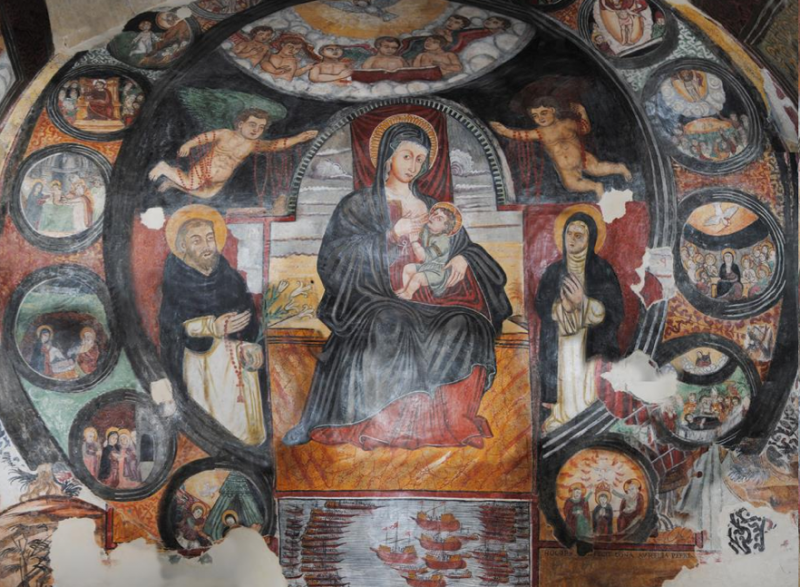Cappella della Madonna del Latte, S. Maria della Pietà, Ugento.
The Cappella della Madonna del Latte is a tiny chapel within the Franciscan convent of S. Maria della Pietà in Ugento (Puglia), built in the last decades of the fifteenth century. There is very little information regarding the construction of the convent and the frescoes of the chapels. The convent was not finished until the end of the century due to the siege of Otranto by the Ottoman Empire, a time when all construction was devoted to fortifications and new defenses for the cities. It would appear that it was Aghelberto del Balzo who decided to dedicate the convent to Santa Maria della Pietà in the 1480s. Aghelberto, son of the Duke of Andria, Francesco III, had taken possession of the fief of Ugento in 1463, as part of the dowry of Maria Conquesta, daughter and heiress of Giovanni Antonio Orsini del Balzo.
The chapel is not located in the main church of the convent dedicated to Saint Anthony; rather, it is part of the convent (now, part of the Archeological Museum). Frescoes cover two walls of the chapel and are not dated. The main one (approximately 400 x 350 cm) depicts the Madonna del Latte within a circle in which the mysteries of the rosary (mysteries of the life of the Virgin Mary) are represented; she is accompanied by Saint Dominic and Saint Catherine of Siena. Beneath this depiction of the Virgin there is a scene of a battle, apparently the battle of Lepanto (1571), for it distinctively shows the way in which the ships of the Holy League (the Papal States, Spain and Venice) formed in the face of the Ottoman forces. These iconographical elements—the saints, the mysteries and the battle scene—follow the standard features of the Virgin of the Rosary and her divine intercession in the battle. However, the Virgin is clearly a Virgin of the Milk. Is it possible, as some corners of the walls suggest, that the fresco was repainted?
Next to this painting is the Madonna del Purgatorio. In a smaller and almost austere representation, the fresco depicts the Virgin appearing in clouds, offering rosaries to the souls in Purgatory. Beneath the Purgatory, a person, probably a mourning woman in a black dress, kneels before the image. The fresco is poorly conserved and there are pieces missing; in the painting’s current state, it is not possible to see either the person or the inscription on the steps. This composition is similar to Catalano's Annunciazione with donors, where a similar set of stairs seems to differentiate spaces: the symbolic realm of the Purgatory and the Virgin above, the space of the donor and devout woman below.
According to Clara Gelao, the standard iconography of the Virgin was taking final shape during the sixteenth century, and it was only after the Council of Trent (1545-1563) that the specific elements associated with different cults of the Virgin were fixed. This could explain why we find elements traditionally associated with the Virgin of the Rosary but not the representation of her miraculous presentation before Saint Dominic in Albi in 1210, where he is supposed to have received the Rosary from her in order to fight heresy. Fraternities of the rosary grew to fight heretic movements in the thirteenth century, and it was later linked to the conversion of infidels, both in Europe and in the Americas. This would explain why the rosary would be used to reinforce devotion in the fight against the Ottoman Empire during the new crusade commanded by Pope Pius V. Conveniently enough, the Habsburgs of Spain had already shown devotion to the Rosary, but their own victorious Virgin was associated with the Reconquista, the Virgen de la Victoria that would eventually be combined with the Virgin of the Rosary as well.
In Puglia, images of the Rosary were disseminated by fraternities with support from Ambrogio Salvio, the Dominican bishop of Nardò from 1569 to 1577. These fraternities commissioned artists to produce images of their churches’ patrons. Some of these fraternities even became active in the construction of the iconography of their devotions. Two of the most popular fraternities in this region were the ones devoted to the Virgin of the Rosary and the Virgin of the Purgatory, both of which appear in the Cappella della Madonna del Latte. The chapel was most likely commissioned by a fraternity or donor that may not be associated to the Virgin of the Rosary as such, but was linked to the battle, explaining why it’s included in the Chapel. However it is possible that the Madonna del Latte was transformed to suit the devotion of the Rosary by veterans of the battle of Lepanto, thus explaining the conflations in the two iconographies.
October 21, 2019
Bibliography
Braudel, Fernand. El Mediterráneo y el mundo mediterráneo en la época de Felipe II. Translated by Mario Monteforte Toledo, Wenceslao Roces, and Vicente Simón. 2 vols. Madrid: Fondo de Cultura Económica, 1976.
Capotorti, Mario. “Il mito di Lepanto e la sua utilizzazione nell’iconografia sacra in età postridentina: Episodi salentini.” In La Puglia, il manierismo e la controriforma, edited by Antonio Cassiano and Fabrizio Vona, 147-162. Galatina: Mario Congedo Editore, 2013.
Capotorti, Mario. “La battaglia di Lepanto e l'iconografia di Santa Maria della Vittoria: Spunti per una ricerca.” In Ottant'anni di un maestro: Omaggio a Ferdinando Bologna, edited by Francesco Abbate, 337-343. Naples: Paparo Edizioni, 2006.
Gelao, Clara, ed. Confraternite, arte e devozione in Puglia dal Quattrocento al Settecento. Naples: Electa, 1994. Exhibition catalog.
Le Goff, Jacques. El nacimiento del Purgatorio. Translated by Francisco Pérez Gutiérrez. Madrid: Taurus, 1981.
Miguez, Victor. Infierno y gloria en el mar: Los Habsburgo y el imaginario artístico de Lepanto (1430-1700). Castellò de la Plana: Universitat Jaume I, 2017.
Soja, Edward. Postmodern Geographies: The Reassertion of Space in Critical Social Theory. London: Verso, 1989.
All images of the chapels are drawn from the website of the Sistema Museale Ugento
Querejazu, Lucía. “The Cappella della Madonna del Latte in Ugento and the Iconography of the Rosary.” In Michael Cole and Alessandra Russo, eds. Spanish Italy & the Iberian Americas. New York, NY: Columbia University, 2019. <https://doi.org/10.7916/GVAH-K811>


